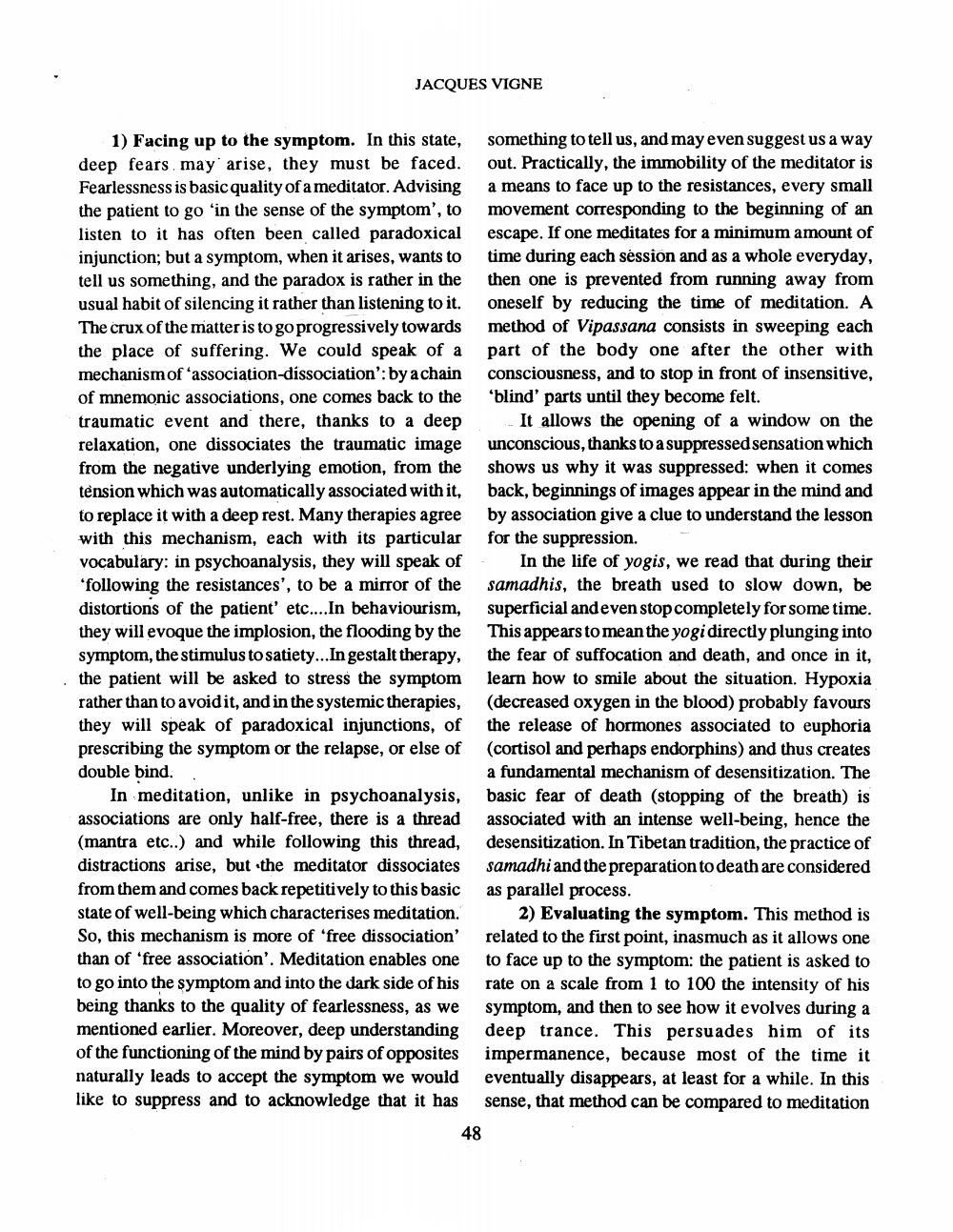________________
JACQUES VIGNE
1) Facing up to the symptom. In this state, something to tell us, and may even suggest us a way deep fears, may arise, they must be faced. out. Practically, the immobility of the meditator is Fearlessness is basic quality of a meditator. Advising a means to face up to the resistances, every small the patient to go 'in the sense of the symptom', to movement corresponding to the beginning of an listen to it has often been called paradoxical escape. If one meditates for a minimum amount of injunction; but a symptom, when it arises, wants to time during each session and as a whole everyday, tell us something, and the paradox is rather in the then one is prevented from running away from usual habit of silencing it rather than listening to it. oneself by reducing the time of meditation. A The crux of the matter is to go progressively towards method of Vipassana consists in sweeping each the place of suffering. We could speak of a part of the body one after the other with mechanism of association-dissociation': by a chain consciousness, and to stop in front of insensitive, of mnemonic associations, one comes back to the 'blind' parts until they become felt. traumatic event and there, thanks to a deep It allows the opening of a window on the relaxation, one dissociates the traumatic image unconscious, thanks to a suppressed sensation which from the negative underlying emotion, from the shows us why it was suppressed: when it comes tension which was automatically associated with it, back, beginnings of images appear in the mind and to replace it with a deep rest. Many therapies agree by association give a clue to understand the lesson with this mechanism, each with its particular for the suppression. vocabulary: in psychoanalysis, they will speak of In the life of yogis, we read that during their 'following the resistances', to be a mirror of the samadhis, the breath used to slow down, be distortions of the patient' etc....In behaviourism, superficial and even stop completely for some time. they will evoque the implosion, the flooding by the This appears to mean the yogi directly plunging into symptom, the stimulus to satiety... In gestalt therapy, the fear of suffocation and death, and once in it, the patient will be asked to stress the symptom learn how to smile about the situation. Hypoxia rather than to avoidit, and in the systemic therapies, (decreased oxygen in the blood) probably favours they will speak of paradoxical injunctions, of the release of hormones associated to euphoria prescribing the symptom or the relapse, or else of (cortisol and perhaps endorphins) and thus creates double bind..
a fundamental mechanism of desensitization. The In meditation, unlike in psychoanalysis, basic fear of death (stopping of the breath) is associations are only half-free, there is a thread associated with an intense well-being, hence the (mantra etc..) and while following this thread, desensitization. In Tibetan tradition, the practice of distractions arise, but the meditator dissociates samadhi and the preparation to death are considered from them and comes back repetitively to this basicas parallel process. state of well-being which characterises meditation. 2) Evaluating the symptom. This method is So, this mechanism is more of 'free dissociation related to the first point, inasmuch as it allows one than of 'free association'. Meditation enables one to face up to the symptom: the patient is asked to to go into the symptom and into the dark side of his rate on a scale from 1 to 100 the intensity of his being thanks to the quality of fearlessness, as we symptom, and then to see how it evolves during a mentioned earlier. Moreover, deep understanding deep trance. This persuades him of its of the functioning of the mind by pairs of opposites impermanence, because most of the time it naturally leads to accept the symptom we would eventually disappears, at least for a while. In this like to suppress and to acknowledge that it has sense, that method can be compared to meditation
48




